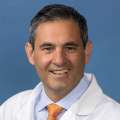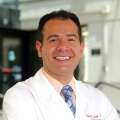Eight months after a massive heart attack, Sammy Saab, MD, MPH, medical director of the Adult Liver Transplant Program at UCLA Health, trekked 60 miles of mountain trails with his 17-year-old daughter’s Girls in Boy Scouts of America troop.
As he carried a 50-pound pack, Dr. Saab sometimes feared he could die in the remote New Mexico wilderness.
Yet as he trudged through storms and mud over the summer, he found confidence and inspiration thinking about Tamer Sallam, MD, PhD, the UCLA Health cardiologist who helped save his life.
“When I was on the hike all I could think about was Tamer and how I’m going to thank him when I get back,” Dr. Saab said. “If it wasn’t for him, I wouldn’t be doing it. I thought about him every day.”
Dr. Sallam said he wasn’t expecting to care for a colleague on that October 2020 day at Ronald Reagan UCLA Medical Center. Although now, Dr. Saab is also his friend.
“A lot of it comes down to the basic principles that guide any patient-physician relationship, which is based on trust, being ethically responsible, trying to advocate for your patient’s welfare – whether they’re a physician or not – and making recommendations based on the evidence,” Dr. Sallam said.

“I don’t see him as this well-known physician at UCLA, I see him like he could be my brother and how would I want him being treated.”
2 workouts, 1 ambulance ride
On a Tuesday afternoon last fall, Dr. Saab finished a 30-minute stair workout before rushing to his home office for a Zoom meeting without time to shower. He began feeling heaviness and squeezing in his chest. His asthma inhaler and an antacid provided no relief.
“When I realized it was probably a heart attack, I took a quick shower. I was pretty smelly,” said Dr. Saab, who also ran four miles early that morning.
Dr. Saab, who was 52 at the time, called 911 and directed the ambulance to take him to Ronald Reagan UCLA Medical Center, next door to his office in the Medical Plaza.
Dr. Sallam, co-director of the UCLA Cholesterol Management Center, was on call overseeing the cardiac care unit when he got a page with Dr. Saab’s name. He’d never met him but knew he also cared for critically ill patients at the hospital.
“I initially thought it must be an error,” Dr. Sallam said. “I thought they probably paged me with a supervising physician name.”
He soon discovered that Dr. Saab was his emergency patient despite no history of heart problems.
“Sammy was arguably the poster child for a healthy person, exercising twice a day and not having any seemingly obvious risk factors,” Dr. Sallam said. “But unfortunately, this is the humbling nature of this disease; 15% of patients who have their first heart attack don’t have any obvious predisposing conditions.”

Diagnosis and treatment
Dr. Sallam’s team began their evaluation and an EKG showed that Dr. Saab had suffered what’s known as a “widow maker” heart attack, which involves the blood vessel that supplies up to half of the heart muscle.
“The key is to move quickly and initiate treatment right away,” he said. “Even a few minutes can be the difference between tens of millions of dead or healthy heart cells.”
They administered medication and cardiologist Rushi Parikh, MD, performed an emergency angioplasty to remove the clot and place a stent.
Dr. Saab, who was hospitalized for the first time since childhood, said he adjusted easily to being a patient rather than a provider. Colleagues dropped by to say hello. Due to COVID-19 protocols, only his wife could visit. His four children made a big sign and stood outside his window. He had his laptop to respond to work emails.
“I’m a big believer in karma,” he said. “I’ve always been very sensitive to patients. I always picture myself as a patient and that’s how I treat people. It wasn’t a big adjustment. I felt empowered, they answered all my questions.”
Dr. Saab spent two days in the ICU and two more in a recovery unit before he was released. He went back to work on the following Monday and started the process of recovery, both physically and psychologically.
He underwent cardiac rehab, a program of supervised exercise, based on the recommendation of Dr. Sallam.
“I didn’t think I needed it, but in reality I needed it,” he said. “It was a great boost to my mental health. It gave me a lot of confidence.”
Dr. Saab takes about seven medications, including a twice-a-month injectable to treat a type of bad cholesterol called lipoprotein A (LPA) that isn’t captured on a traditional lipid panel but increases the risk of heart disease. Some of his family members see Dr. Sallam after Dr. Saab’s brothers and son were tested for elevated LPA.
He said managing his own medication has helped him realize the intricacies that patients face. He now spends more time explaining the purpose of what he prescribes.
“I can’t pronounce the drugs I take,” Dr. Saab said. “Now I can see how easy it is to get medication confused.”

Moving forward
Dr. Saab is treated by a team of UCLA Health cardiologists, including Dr. Parikh and Eric Yang, MD, and sees Dr. Sallam every few months. He still exercises twice a day, although his running pace isn’t as fast as before.
“Physically he feels great and I’m expecting that his prognosis is excellent based on all the data we have,” Dr. Sallam said.
After Dr. Saab returned from the June hiking trip, he sent a letter to Dr. Sallam chronicling the hailstorm, gushing winds, hypothermia and dehydration he faced.
“Nevertheless, spending time with my daughter during those 12 days was priceless,” he wrote. “I wanted to thank you for helping make this trip possible.”
Courtney Perkes is the author of this article.





